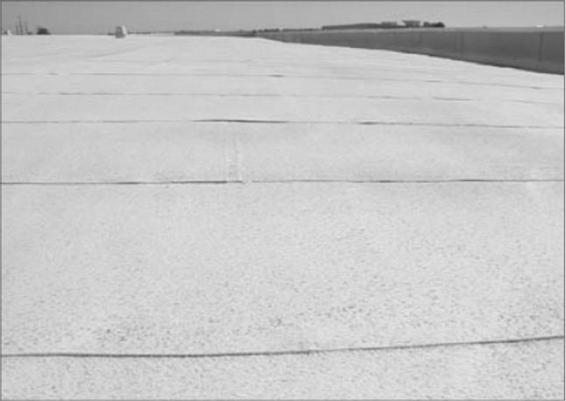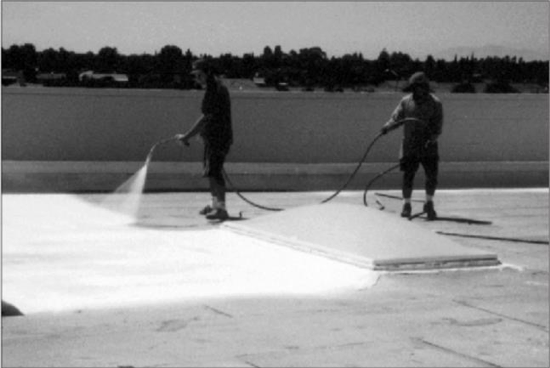Cool Paint
Introduction
Coatings and paints with the highest level of solar reflectance are usually white in colour. They often contain transparent polymeric materials such as acrylic, which make them waterproof and flexible and white pigment to make them reflective and opaque. White pigments include substances such as titanium dioxide and zinc oxide. These coatings and paints can reflect up to 80% of the sun’s energy1.
Cool paint is one of the mitigation technologies used to reduce cooling loads in buildings. It is a passive building energy saving solution, which helps to lower surface temperatures of the urban environment by reflecting solar radiation before it can be absorbed. Benefits of cool paint include energy savings, improved thermal comfort, mitigating the UHI effect and potentially cooling global temperatures2.
Paints or coatings coloured with conventional pigments, even if they are light coloured, tend to absorb near-infrared radiation. Cool paint, on the other hand, reflects large parts of the near-infrared range (NIR) radiation due to its more selective absorption band in the infrared part of the solar spectrum3,4. As a result, surfaces with cool paint have lower surface temperatures and are therefore cooler. This is illustrated in Figure 1, where 1 and 2 show the visible and infrared images respectively of a cool black coating, while 3 and 4 show that of a standard black coating2.

Figure 1 Visible and Infrared Images of Cool and Standard Black Coatings
(Source: Synnefa et al., 2007a)
Cool paint is a type of cool material, which can be applied on the exterior surfaces of buildings, such as roofs and walls, and other urban surfaces like pavements and parking lots4. Cool paint can be used on most roof surfaces; as a retrofit on existing roofs, or on newly built roofs as well5,6. It is also suitable for both lightweight and heavyweight roofs as there are minimal structural issues associated with cool paint6.
For cool surface coatings, the two main types (cementitious and elastomeric) differ in terms of their composition. Cementitious coatings contain cement particles (Figure 2), while elastomeric coatings contain polymers (Figure 3). Some of the possible polymers used are acrylic, silicone and urethane, with acrylic being the most common in elastomeric coatings5. Typically, cool paint adheres easily to the roof substrate, is durable, weather-resistant, and has some degree of anti-fungal, anti-algal and ‘self-washing’ ability, which allows it to shed dirt from the surface under normal rainfall. As compared to cementitious coatings, elastomeric coatings perform much better in terms of adhesion and durability5 due to its elastic properties, which give it its “rubber-like” flexibility. This allows the coating to stretch and contract in the heat without damage7.

Figure 2 Example of Cementitious Cool Roof Coating
(Source: Gartland, 2008)

Figure 3 Application of an Elastomeric Cool Roof Coating
(Source: Gartland, 2008)
Advantages and Disadvantages of Cool Paint
Cool paint is a heat reflective technology for exterior building surfaces, which has numerous well-documented benefits, particularly in terms of increasing sustainability, and mitigating the urban heat island effect.
Advantages of Cool Paint Application
| Aspects | Benefits | Underpinning Literatures |
| Energy Savings | high solar reflectance and infrared emissivity properties result in less heat penetrating the building envelope thus reducing energy consumption | Urban & Roth (2012)8; Chen (2016)2
|
| Improved Thermal Comfort | indoor thermal comfort for occupants is improved by lowering temperatures within the building and decreasing the hours of discomfort | Synnefa et al., (2007b)9; Akbari & Matthews (2012)10 |
| Extended Roof Service Life | higher temperatures can accelerate material degradation, by maintaining roof surfaces at lower average temperatures, it could, in principle, slow down heat-related degradation | Urban & Roth (2012)8 |
| Mitigate Urban Heat Island Effect | increasing the albedo of roofs reduces ambient temperatures at 2 m height above the ground in urban areas (an average temperature decrease of almost 0.2 K per 0.1 increase in roof albedo) | Rosenzweig et al. (2006)11; Synnefa et al., (2008)12; Santamouris (2014)13 |
| Minimise Smog Formation | photochemical reactions of smog, formed when heat and light from the sun react with pollutant particles in the atmosphere, increase when temperatures are high | Cool Roof Rating Council (2006 & 2010)14,15 |
| Global Cooling Potential | increasing worldwide urban albedos by replacing conventional roofs with cool materials could potentially slow down the current rate of global warming, though negative radiative forcing | Lawrence Berkeley National Laboratory (2008)16; Menon et al. (2010)17; Akbari & Matthews (2012)10; Chen (2016)2 |
| Utility Grid Benefits | lower temperatures reduce the peak electricity demand from air conditioning | Cool Roof Rating Council (2006)14; Global Cool Cities Alliance (2012)18; Chen (2016)2
|
Amidst its various benefits, cool paint has its share of disadvantages such as the following:
Disadvantages of Cool Paint Application
| Aspects | Disadvantages | Underpinning Literature |
| Albedo Degradation | exposure to external conditions over time may affect the solar reflectance of a surface due to ageing, weathering and soiling; particularly due to dirt accumulation and microbial growth | Levinson et al. (2005)19; Sleiman et al. (2011)20; Chen (2016)2
|
| Ponding and Moisture Accumulation | after rainfall due to an insufficient slope or drain blockage, in which water accumulates in pools on the roof; moisture in indoor air to condense within roof materials | Global Cool Cities Alliance (2012)18; Chen (2016)2 |
| Increased Glare and Unwanted Solar Gains | solar radiation reflected away from very reflective roof or wall surfaces could in turn be reflected into the windows and openings of adjacent buildings | Global Cool Cities Alliance (2012)18; Chen (2016)2 |
| Potentially Worsen Global Warming | raised concerns about the significant uncertainty in estimating the effect of UHI on global warming, assumption-dependent results of the study, statistically insignificant numerical results and insufficient level of detail in the model when simulating the effects of local factors like moisture and cloud feedbacks on the global climate; the effect of cool roofs on energy usage, and thereby carbon emissions were not accounted for | Jacobson & Ten Hoeve (2012)21; Menon, et al. (2011)22; Chen (2016)2
|
| Heating Penalty | in winter, this reduction in heat penetration becomes a drawback as desirable heat is reflected away | Hernández-Pérez et al. (2014)23; Chen (2016)2 |
| Difficulty in Computing Exact Cost Savings | uncertainty and difficulty in estimating accurate cost savings becomes a significant obstacle in encouraging the adoption of cool paint | Urban & Roth (2012)8; Chen (2016)2
|
| Heat Mitigation Effect Limited to Top Floor Units | applying cool paint on the roof of a high-rise building may not be very effective when evaluating it in terms of the overall impact as benefits of heat mitigation and the resulting energy savings are only felt by occupants in the top floor units | Hall & Khan (2003)24; Chen (2016)2 |
| High Installation and Maintenance Cost | high installation and maintenance costs for cool paint are significant considerations for policy makers which are not so easily overlooked | Chen (2016)2 |